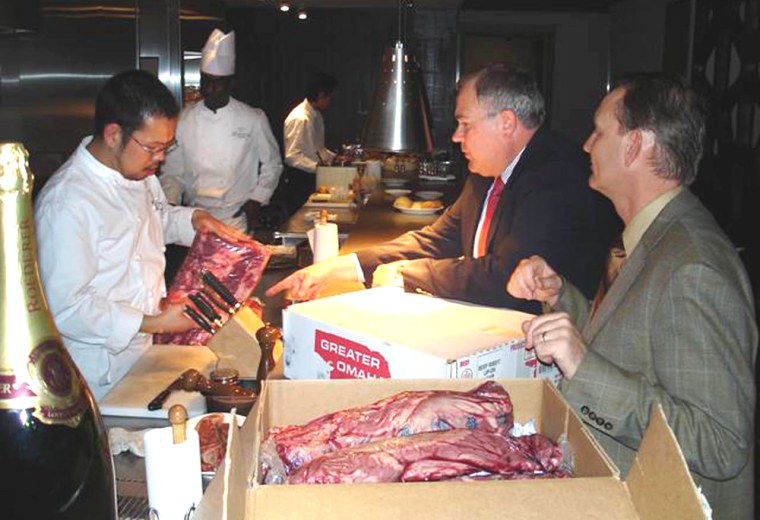The California red was served, the oysters on the half-shell consumed. Finally, Bumpei Kawanaka had what he really wanted on his fork: a glistening red slice of American steak.
“It’s very juicy and, of course, tasty,” Kawanaka said between bites as he became one of the first people in Japan to savor U.S. beef since the country eased an import ban last week. “It’s a special taste.”
American beef made a small but significant appearance on grills in Japan on Monday, signaling what U.S. producers hope will be a triumphant return to what once was their most lucrative overseas market.
The feasts — at a private party in Tokyo and a chain of barbecue restaurants in western Japan — followed limited meat shipments in recent days allowed by Japan’s Dec. 12 decision to partially lift its embargo.
Japan shut its doors to American beef imports in December 2003 after the first U.S. case of mad cow disease, depriving producers of a $1.4 billion market — and consumers of a favorite meal.
The private banquet in Tokyo attended by Kawanaka was hosted by the state of Nebraska, which held a good chunk of the market before the ban. U.S. officials praised the lifting of the embargo — and then lifted some ribeye to their lips.
“We are so happy ... to have you as the first people to taste the beef which we all know is delicious, safe and affordable,” Dan Berman, minister-counselor for agricultural affairs at the U.S. Embassy, told some 30 guests before slicing into a steak.
At around the same time in western Japan, the wider public got its first mouthfuls at the Zenshoku Korean barbecue chain.
American beef was on the menu in 30 restaurants in that region Monday, and was to return to 26 outlets in Tokyo and other parts of eastern Japan on Tuesday.
“We’ve been waiting for this day for so long,” gushed Hideyuki Wakita, manager of a Yakiniku-Den outlet as he served up grilled meat in Osaka.
Despite the celebrations, it was expected to be weeks or even months before Japanese shoppers at supermarkets or diners at popular and cheap beef-and-rice bowl outlets savor their first tastes of U.S. beef.
Yoshinoya, a favorite beef bowl chain, also is concerned that remaining restrictions on U.S. imports will limit beef’s availability. Japan has agreed to only import beef from U.S. cows aged 20 months or younger — a small percentage of the American herd.
Dissatisfaction with the limit was in the air as Monday’s limited group of beef-lovers enjoyed their dinners.
“I want them to change it to up to 30 months,” said beef importer Masaru Fukuzawa at the Nebraska gathering. “Wouldn’t free competition be better?”
The American beef debut caps a long voyage back to the Japanese market.
Japan shut its ports to U.S. beef on Dec. 24, 2003, after the discovery of the first case of mad cow disease — formally known as bovine spongiform encephalopathy — in the U.S. herd.
At first, Tokyo demanded that Washington test each head of cattle as it goes to slaughter as Japan has done to contain its own mad cow spread, but U.S. producers balked, saying that was too costly and unnecessary.
After months of negotiation, the two sides agreed to allow the importation of meat from younger cows, which so far have been free of the disease. Japan’s Food Safety Commission approved that decision last week.
U.S. beef still faces an uphill struggle in Japan, where consumers are particularly sensitive to safety concerns. Some restaurants are reluctant to market American meat until they are sure the public will be receptive.
Greg Ibach, director of the Nebraska Department of Agriculture, hit hard on those doubts in a toast Monday, assuring diners that producers were willing to go all out to win back Japanese palates.
After all, big money is at stake: Nebraska beef sales were between $150 million and $300 million a year in Japan before the ban.
“Over the past two years, our producers ... have embraced evolving international standards to maintain our reputation,” Ibach said before digging in.
